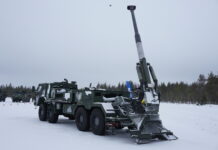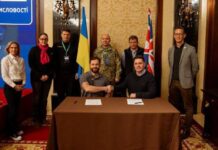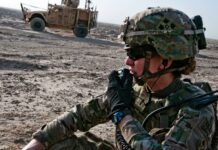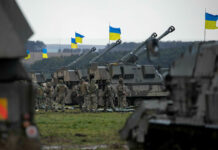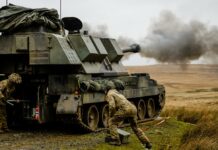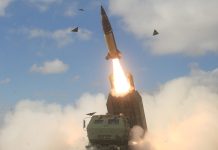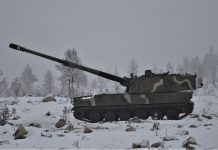On 21 September 2022, Hanwha Defence unveiled a prototype version of their developmental K9A2 Self-Propelled Howitzer (SPH) for the first time at the DVD 2022 defence exhibition at Millbrook Proving Ground, in the UK. The vehicle was presented as part of the company’s bid for the UK’s Mobile Fires Platform (MFP) future artillery programme.
The K9A2 is the latest variant of the K9 THUNDER tracked SPH family developed by Hanwha, and represents a major upgrade over the earlier K9 and K9A1 variants. The vehicle features improvements to fire rate, automation, crewing, and quality of life changes for the crew. The vehicle also provides a capability growth option for its existing userbase, with Hanwha stating that any earlier variant in the family could be upgraded to the K9A2 standard. South Korea has already mandated that 50% of their K9 platforms would be upgraded to K9A2 following the completion of its development, in a programme which has already been fully funded. According to Hanwha’s timetable development of the K9A2 is due to be completed in 2025, with deliveries to the South Korean Army to start in 2026 or 2027.
New Thunder, New Capabilities
In terms of armament, the K9A2 retains the 155 mm/L52 gun used by earlier family variants, providing a representative maximum range of approximately 50 km with rocket-assisted projectile (RAP) rounds, though this could potentially be greater depending on the ammunition nature used. The gun supports NATO Joint Ballistics Memorandum of Understanding (JBMoU)-compliant 155 mm projectiles with a 23 litre combustion chamber volume, and has been successfully tested with various guided projectiles including the EXCALIBUR GPS guided round. A representative stated that some users had also expressed an interest in operating their K9 SPHs with Leonardo VULCANO Guided Long-Range (GLR) sub-calibre guided projectiles using the semi-active laser (SAL) guidance option. According to Leonardo, this would enable fire missions out to 70 km, with a circular error probable (CEP) of ≤3 m. In addition to the aforementioned natures, some K9 user nations are in the process of qualifying Northrop Grumman’s Precision Guidance Kit (PGK) for their K9s. This is a fuze kit which allows a user to convert unguided rounds to GPS-guided rounds by swapping the fuze for the PGK and using an ammunition programmer to input the projectile’s target coordinates.

The K9A2’s turret is electrically driven with manual backup for emergencies, providing traverse through 360° and the gun’s depression and elevation range is from -2.5° to +70°. As with earlier variants of the K9 family, the digital fire control system is highly automated and can be linked to external command-and-control (C2) assets, permitting automatic gun laying onto targets located by friendly reconnaissance assets and distributed over the C2 network. This assists the crew in conducting rapid fire missions in shoot-and-scoot scenarios, since targets can be pre-assigned.
Despite many similarities, the turret has seen substantial modification compared to earlier K9 variants, both internally and externally. Perhaps the most notable new feature of the K9A2 is its rather innovative automatic ammunition handling and loading system, which permits reloading at any turret traverse position or gun elevation. The earlier K9 and K9A1 relied instead upon a semi-automatic loading system, in which the rounds were loaded automatically, while the charges were loaded manually. As a result, the K9A2 is capable of attaining a fire rate of at least 9 rds/min, compared to the K9 and K9A1’s maximum of 6 rds/min. This has also allowed Hanwha to reduce the vehicle’s crewing requirements, from five crew on earlier variants, to three on K9A2.
The K9A2’s loading system operates using a projectile conveyor, drop-down stacked propellant racks, a sliding tray, and a breech-mounted feed tray. In operation, the projectile and charge(s) are loaded onto a sliding tray, positioned side-by-side before being pushed onto the feed tray. The feed tray is then aligned with the elevation of the gun breech, and a rammer pushes the projectile, followed shortly after by the charge(s) into the chamber. The feed tray then swings upwards, out of the way of the recoiling mass of the gun, and the system is ready to fire. This entire process takes an approximate average of 7.45 seconds, although the process could potentially be faster or slower, depending on various factors, such as the position of the next selected round in the conveyor. In this vein, a Hanwha representative stated that there were two versions of the autoloader in the works, with the ‘V1’ version capable of attaining a maximum fire rate of 9 rds/min (6.66 sec per round), and a ‘V2’ version capable of attaining maximum a fire rate of 10 rds/min (6 sec per round).

To accommodate the ammunition handling system, the turret has been modified, with the bustle lengthened and most of the turret’s roofline raised compared to the earlier K9A1. These changes have provided space to move all 48 rounds and 240 propellant charges into the turret, an improvement on previous variants, which required some of the charges to be kept on the hull floor due to space constraints. A Hanwha representative explained that the reason for the high number of charges was the Korean Army’s requirement was for each round carried to have a possible five charge load (the maximum is six), to ensure sufficient charge supply for most foreseeable fire mission types (hence 5×48=240 charges). Due to this turret redesign, the auxiliary power unit (APU) first implemented on K9A1 has also had to be relocated, from its position on the rear-left of the turret, to an internal position in the rear-right of the hull. Additional changes planned for the production version of the vehicle, but not seen on the prototype include the integration of a remote weapon station (RWS) for self-protection at short ranges, and an air conditioning system for the crew.
Hanwha company representatives stated that the prototype vehicle shown was the exact vehicle being used for development trials in South Korea, and was shipped over to the UK for the exhibition. While many features on the vehicle would be representative of the final design, there were also a number of key differences between prototype and the likely final vehicle. For one, the prototype vehicle only had seats for two crew, a driver and a gunner, with the latter seated in rear-right of the hull, behind the turret. A Hanwha representative explained that the final design would use three crew, a driver, gunner, and commander, and the latter two crew would be seated in a turret basket, with commander located on the left side of the gun and the gunner located on the right side. Both would be provided with the same multifunctional display and common controls. A further difference was that the autofrettaged barrel used on the prototype did not feature a chrome lining, a feature which company representatives stated was not being used for trials, but was planned for inclusion in the production version.
In terms of protection, the vehicle hull has an all-round protection rating of STANAG 4569 Level 3, while the turret was understood to be approximately STANAG 4569 Level 1. Hanwha representatives stated that the platform had additional growth potential for 3 tonnes of weight, allowing some further protection to be added if required. However, realistically for most users this option would probably only be exercised to add mine protection, since by virtue of its role the vehicle is not intended for front line combat, and 3 tonnes would only provide room for very marginal improvements to passive ballistic protection. The platform is equipped with a 745.7 kW (1,000 hp) engine, providing 15.86 kW/tonne (21.27 hp/tonne) when equipped with CRTs, and a hydro-pneumatic suspension system, enabling variable ground clearance.
K9 and MFP
If selected for the UK’s Mobile Fires Platform (MFP) programme, Hanwha is offering to produce the UK variant of K9A2 using >50% of local content, and has put together ‘Team Thunder’, a collection of UK-based industries, to help the UK deliver this capability domestically. The members of Team Thunder and their roles comprise:
- Hanwha Defense – Prime contractor and design authority.
- Lockheed Martin UK (Ampthill facility) – Turret production, platform and systems integration, and trials.
- Pearson Engineering (Newcastle facility) – Hull fabrication and manufacturing, integration.
- Leonardo UK (Edinburgh facility) – Production of on-board navigation and pointing systems.
- Soucy Defense (Devon facility) – Production of Composite Rubber Tracks (CRTs).
- Horstman (Bath Facility) – Production of hydro-pneumatic suspension units and other running gear components.
It is noteworthy that Team Thunder announced their intention at the outset to offer the K9A2 to the UK with Soucy composite rubber tracks (CRTs). The tracks dampen vibration and decrease the acoustic signature of the vehicle, as well as decreasing its weight, from 49 tonnes with conventional steel tracks, to 47 tonnes with CRTs. A Soucy representative stated that the company’s tracks were typically tailored to a specific platform, and a 47 tonne weight target could be met. Additionally, he noted that Soucy was already in the process of developing CRTs with a 55 tonne weight limit, but did not provide a definitive timescale for the completion of this effort.

In terms of meeting transportability requirements, Hanwha representatives stated that due to its size and weight, the K9A2 could only be transported by C-17 or larger aircraft, and is therefore incapable of being transported via A400M. While this may be potentially problematic, to various degrees the same problem is likely to apply to a few of the K9A2’s competitors for the MPF programme, albeit not all of them. On the tactical mobility side, as the one of the very few tracked options for the MFP programme, the K9A2 would be expected to outperform its wheeled competition in terms of terrain trafficability, soft soil mobility, and hill climbing. These tractive advantages would also carry over to the accompanying K10 autonomous ammunition resupply vehicle, which operates alongside the K9, and can automatically resupply the SPH with ammunition at a rate of 10 rds/min.
While Team Thunder’s offer presents a number of compelling positives, and represents an upgraded form of continuity for the UK’s existing tracked artillery fleet, much is dependent on how the British Army will decide to weight its various requirements.
Future Development
Further down the line, Hanwha plans to build on the K9 family’s level of automation in their development roadmap, which plans for a K9A3 variant to complete development in the 2030s. The K9A3 is set to feature a 155 mm/L58 gun, increasing the effective range for standard shells by approximately 10 km. The vehicle is also due to be provided with improved automation capabilities, enabling fully automated operation, including autonomous driving. Under Hanwha’s roadmap, this is due to be completed in the 2030s.
Beyond this, Hanwha plans to build a fully robotised variant of the K9, with manned-unmanned teaming capabilities. At present, this variant is only known under the working designation ‘K9 Next Generation’. The envisaged setup involves a single manned SPH teamed with two unmanned SPHs, thereby enabling a battery of six SPHs consisting of two manned and four unmanned vehicles. This is of particular interest when considering falling recruitment among many developed countries for demographic or comparative reasons. Under present company plans, this variant is slated for completing development in the 2040s.
The K9 family therefore appears set for a long developmental life, with a growing userbase, upgrade path, and plans for integration of various new or experimental technologies over time. It will be interesting to see how these planned changes will turn out, but based on current trends the K9 family’s future looks promising.
Mark Cazalet





